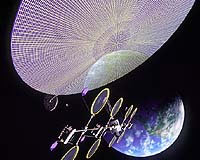Beam solar energy directly from space, and disaster relief expeditions could power all their equipment with no more than a few portable antennas and converters. Campers could use such energy to cook dinners using nothing more than a cell phone-like device. But the primary beneficiaries of such a technological feat would be the many communities that would be able to tap into space solar energy fed into power grids.
Terrestrial solar power stations already exist throughout the world. But sunlight is eight times less intense on the earth's surface than in its geostationary orbit. So why not collect it in space and beam its energy to Earth via microwave power beam, which can penetrate the atmosphere more efficiently, ask U.S. researchers.
They have proposed putting in orbit mega-satellites -- giant, possibly inflatable structures of photovoltaic arrays and antennas -- that would do just that. At receiving stations on Earth, the beam could be converted into electricity or synthetic fuels, which, in contrast to power from terrestrial solar power stations, would flow continuously to the grid independent of the season, weather or location.
The idea has been studied by the Energy Department and the National Aeronautics and Space Administration. In the mid-1990s, a NASA study headed by John Mankins produced a road map for related research and development that was endorsed by the National Research Council.
It envisioned several dozen solar power satellites in geostationary orbit by the year 2050, sending between two gigawatts and five gigawatts of power to multiple locations on Earth. However, the program "has fallen through the cracks because no organization is responsible for both space programs and energy security," Mankins says.
In recent decades, the technologies essential to the concept have made "tremendous" progress, he told USINFO. For example, efficiency of solar power generation and wireless power transmission has more than quadrupled, allowing for significant reductions in the size, mass and potential costs of the solar power systems.
Martin Hoffert, former chair of the Department of Applied Sciences at New York University, told members of the Capitol Hill Club in August that space solar power research and development can proceed with existing technologies.
But the potential costs remain high, discouraging entrepreneurs and the government from investing in it. The major expense -- transporting equipment and materials into orbit aboard a space shuttle -- is $20,000 per kilogram of payload, or the carrying capacity of a space vehicle.
Proponents of space solar power believe the project would become viable economically if the payload cost could be reduced to below $200 per kilogram, and the total expense of delivery and robotic assembly on orbit could be brought below $3,500 per kilogram.
That is not likely to happen any time soon and a reusable launch vehicle, needed to reduce costs drastically, eventually would require government investment, Mankins said. He said, however, that a small-scale demonstration project of the space solar power concept could help convince skeptics and provide a strong political justification for such an investment.
Mankins believes the U.S. government is likely to return to the space solar power idea because of its many potential benefits and applications, including providing power for space exploration and commercial development of space resources.
In September 2006, the House of Representatives' science subcommittee reviewed the concept as part of a hearing on climate change technologies. In addition, the Department of Defense is conducting a feasibility study of space-based solar power. The study is scheduled to be completed in September.
Nevertheless, Mankins admitted that his advocacy of the technology is somewhat romantic.
"But when you look at the kind of things we as a modern society spend billions of dollars on, [supporting] the idea of limitless clean energy from space is not such a bad goal," he said.

